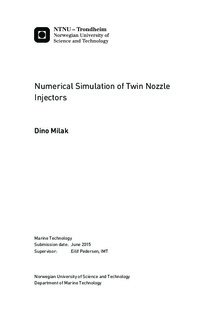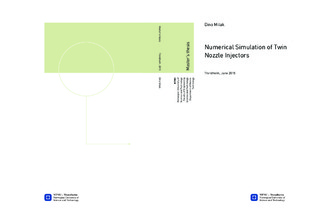| dc.description.abstract | Fuel injectors for marine applications have traditionally utilized nozzles with symmetric equispaced orifice configuration. But in light of the new marine emission legislations the twin nozzle concept has arisen. The twin nozzle differs from the conventional configuration by utilizing two closely spaced orifices to substitute each orifice in the conventional nozzle. Injector manufacturers regard twin nozzle injectors as a promising approach to facilitate stable spray patterns independent of the fuel quantity delivered through the nozzle. If true, injector systems in dual fuel engines can be simplified by reducing the amount of nozzles needed. It is also believed that twin nozzles can improve mixture formation for the combustion process for all diesel applications.
This thesis explores the possibility of using the commercial computational fluid dynamics (CFD) software AVL FIRE to predict the behaviour of L'Orange's twin nozzle during fuel injection. The thesis does not seek to verify and validate the proposed numerical model, but rather perceive an understanding of the overall flow trend in a twin nozzle and how it may outperform a conventional nozzle.
The nozzle is represented by a moving grid where the moving part replicates the needle movement. The needle profile is a ramp function. To take cavitation in account the numerical model is a multiphase model, containing three phases (diesel, vapour and air). The twin nozzle injects the fuel into a constant volume filled with air. The chosen turbulence model is the high Reynolds number $k-\epsilon$ model.
The mass flow and the velocity is found to be greater for the upper injector hole. A vortex in the SAC volume i.e. the lower part of the nozzle seems to be the reason for this. Cavitation is found to have major effect on internal nozzle flow, especially during opening and closing of the needle. Vapour is formed at sharp injector hole inlets and it travels all the way to the outlets, reducing the effective cross sectional area which the fuel can flow through. In-cylinder pressure and rail pressure is found to have an effect on the nozzle behaviour. It is noted that the numerical model has a discrepancy causing too high air density. This only affects the results obtained downstream of the outlet and not the internal nozzle flow.
The twin nozzle is compared to a conventional single orifice nozzle. The proposed numerical model lack certain features making it difficult to explicitly state if the twin nozzle outperforms the conventional nozzle. However, the outlets in the twin nozzle have a smaller vapour fraction than the outlet in the single orifice nozzle. This enhances the effective cross sectional area and might render twin nozzles more effective for injecting larger quantities even if its injector hole dimensions favour pilot injections. | |

